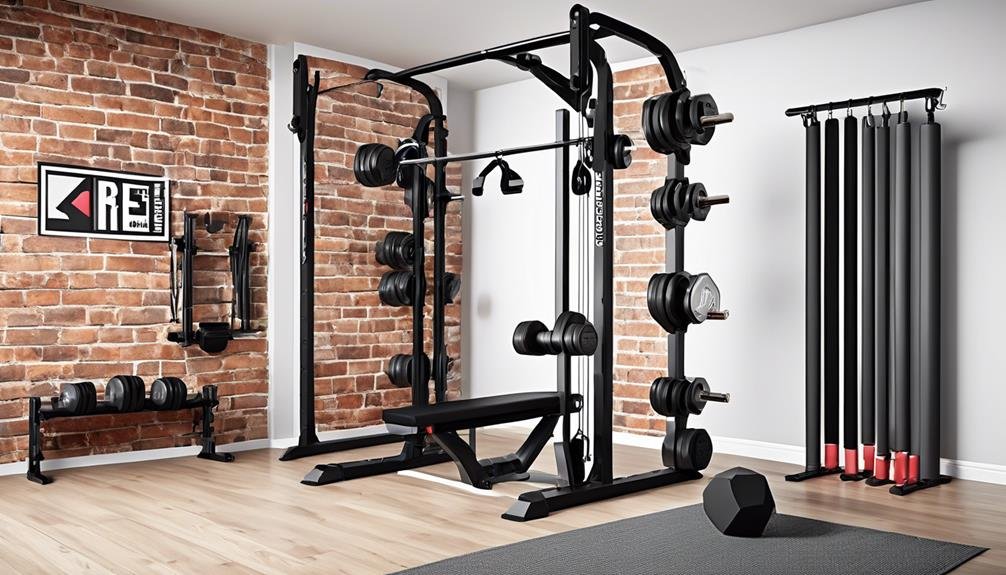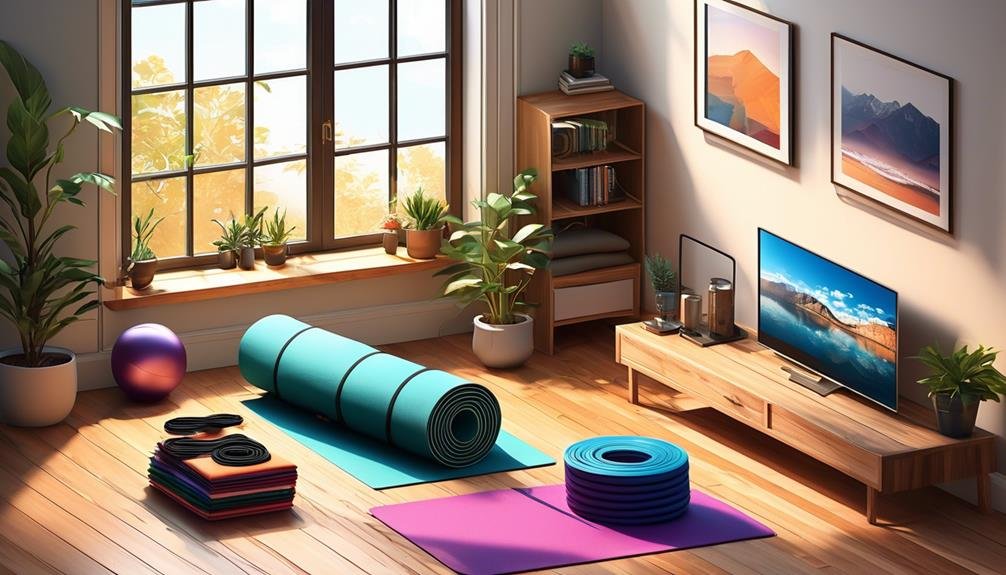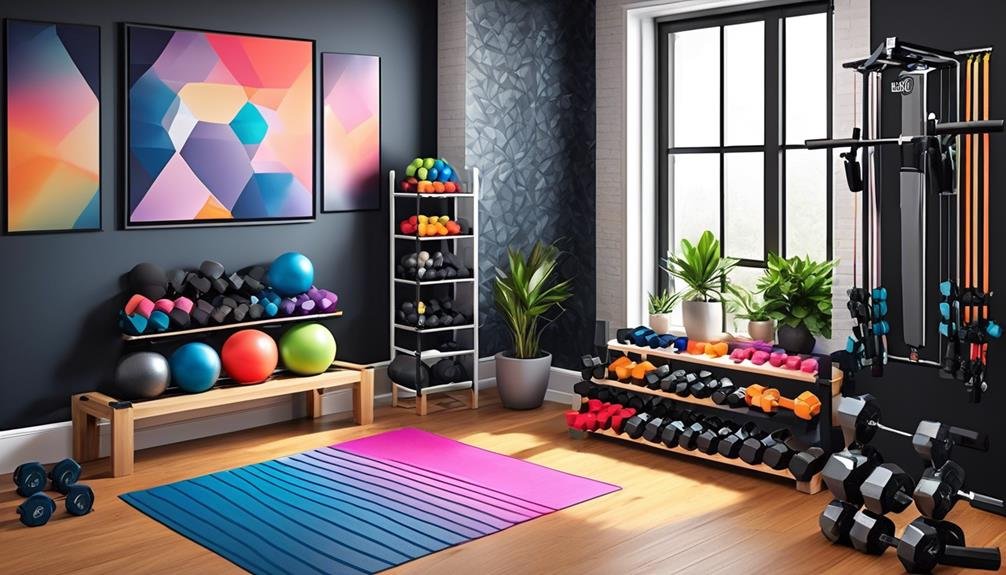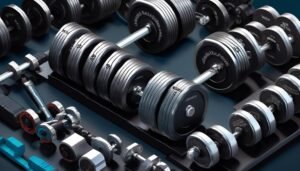Imagine your home gym as a puzzle, with each piece representing a different aspect of your fitness journey.
As you start putting the pieces together, you may find yourself faced with the challenge of building a home gym on a budget.
But fear not, for within this discussion lies the key to unlocking the secrets of creating a cost-effective workout haven.
From assessing your fitness needs to utilizing space-saving equipment, and even incorporating DIY solutions, there are numerous strategies waiting to be discovered.
So, grab your metaphorical toolbox and join us on this journey as we explore the best way to build a home gym on a budget.
Key Takeaways
- Assess your current fitness level and set realistic goals before building a home gym on a budget.
- Prioritize cost-effective equipment options such as adjustable dumbbells, resistance bands, and secondhand equipment.
- Opt for space-saving and multi-functional equipment like adjustable dumbbells or kettlebells, resistance bands, and compact cardio machines.
- Incorporate DIY solutions for home gym essentials to save money and keep the space organized, such as building a power rack or creating DIY plate holders.
Assessing Your Fitness Needs
To assess your fitness needs:
- Start by evaluating your current fitness level and setting realistic goals for improvement.
- Consider the types of exercises you enjoy and the specific areas of your fitness you want to target.
- Take into account any physical limitations or injuries that may impact your workout choices.
- Assess the space available in your home and determine the equipment that can comfortably fit within that space.
- Factor in your budget and prioritize the essential equipment that aligns with your fitness needs.
When building a budget-friendly home gym:
- Adjustable dumbbells are a great investment as they allow you to increase or decrease the weight as needed, making them ideal for strength training.
- Resistance bands are another affordable option that can be used for a variety of exercises, targeting different muscle groups.
- If you're looking to incorporate more strength training into your routine, a weight set can be a worthwhile investment.
Identifying Cost-Effective Equipment Options
Consider these cost-effective equipment options when building your home gym.
To make the most of your budget, opt for multi-tasking tools that can be used for various exercises. Look for secondhand equipment in local classifieds or online marketplaces to save money.
Additionally, prioritize space-saving options that can be easily stored away when not in use.
Start with essential equipment such as resistance bands, dumbbells, and a yoga mat, and gradually add new items to keep costs low.
When comparing prices, make sure to also consider the features and quality of the equipment. For example, an adjustable weight set can be a versatile and cost-effective option, allowing you to increase or decrease the weight as needed.
Another affordable option is a jump rope, which provides a great cardiovascular workout.
Utilizing Space-Saving and Multi-Functional Equipment

If you're looking to maximize your space and budget while building a home gym, incorporating space-saving and multi-functional equipment is key.
To save space, opt for adjustable dumbbells or kettlebells that offer various weight options for different exercises. These versatile options eliminate the need for multiple sets of weights and take up minimal space.
Resistance bands are another great space-saving option as they can be easily stored and offer a wide range of exercises.
Look for a compact and foldable workout bench that can be easily stored when not in use. This allows you to perform exercises such as bench presses and step-ups without taking up too much space.
Consider investing in a suspension trainer like a TRX system, which can be mounted to a door or wall and provides a variety of exercises for strength training.
Additionally, compact cardio machines like folding treadmills or foldable stationary bikes are great space-saving options for getting your heart rate up.
Incorporating DIY Solutions for Home Gym Essentials
Save money and get creative by incorporating DIY solutions for essential home gym equipment. Building a home gym on a budget doesn't mean you have to sacrifice quality or functionality. With a little bit of time and effort, you can create your own DIY gym equipment that will help you achieve your fitness goals without breaking the bank.
Here are three DIY solutions to consider for your home gym:
- Power Racks: Instead of investing in an expensive power rack from brands like Rogue Fitness or REP PR, consider building your own. There are many online resources and tutorials available that guide you through the process. With some basic tools and materials, you can construct a sturdy power rack that will provide the necessary support for heavy lifting.
- Plate Holders: Keep your weight plates organized and easily accessible by making your own plate holders. You can use PVC pipes or wood to create a simple and cost-effective solution for storing your plates. This DIY project won't only save you money but also keep your home gym neat and organized.
- Platform: A lifting platform is essential for protecting your floor and providing a solid surface for lifting weights. Instead of purchasing an expensive platform, consider building your own using stall mats and plywood. This DIY solution is affordable and will provide a stable foundation for your workouts.
Maximizing Free or Low-Cost Workout Resources

Make the most of your budget by maximizing the use of free or low-cost workout resources. When building a home gym on a budget, incorporating these resources can be a great place to start.
Utilize the free workout resources available online, such as YouTube and Amazon Prime workout videos. These platforms offer a wide variety of workout routines and exercises that cater to different fitness levels and goals.
Additionally, take advantage of public spaces like parks and trails for outdoor workouts. These areas provide a scenic and refreshing environment for activities like running, cycling, or even circuit training.
Don't overlook the potential of household items as workout equipment. A chair can be used for step-ups, while a filled water bottle can serve as makeshift weights. Look for free community fitness classes or events in your area. Many communities offer free or low-cost fitness activities like yoga classes or group workouts.
Lastly, take advantage of free trial periods offered by gyms or fitness apps. These trials allow you to access their resources at no cost for a limited time. This can be a great opportunity to try out different workout programs and see what works best for you before investing in the last piece of equipment on your home gym wish list.
Frequently Asked Questions
How to Build a Home Gym on a Budget?
To build a home gym on a budget, start with basic equipment like resistance bands and a yoga mat. Look for secondhand options online to save money. Prioritize versatile tools and gradually add more over time.
Is It Cheaper to Make Your Own Gym?
Yes, it is cheaper to make your own gym. By taking inventory of what you have, buying secondhand equipment, and gradually expanding over time, you can build a budget-friendly home gym that suits your needs.
How Much Will It Cost to Setup Gym at Home?
Setting up a home gym can vary in cost depending on your equipment choices. Prices can range from under $100 for basic essentials to over $4000 for a more extensive setup.
How Much Does It Cost to Build a Basic Gym?
To build a basic gym, you can start with essential equipment like dumbbells, kettlebells, and resistance bands. Consider exploring affordable cardio options such as jump ropes and secondhand treadmills. Gradually expand your collection and prioritize multi-tasking tools.
Conclusion
In conclusion, building a home gym on a budget is achievable with careful planning and smart choices.
Assess your fitness needs and prioritize essential equipment while considering cost-effective options like secondhand purchases.
Utilize space-saving and multi-functional equipment to maximize your workout area.
Incorporate DIY solutions for home gym essentials to save money.
Lastly, take advantage of free or low-cost workout resources to supplement your home gym routine.
With these strategies, you can create a budget-friendly home gym that meets your fitness goals.





